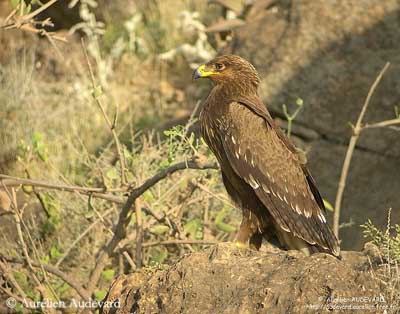

Fr: Aigle criard
Ang: Greater Spotted Eagle
All: Schelladler
Esp: Águila Moteada
Ita: Aquila anatraia maggiore
Nd: Bastaardarend
Sd: större skrikörn
Photographers:
Aurélien Audevard
OUESSANT DIGISCOPING
Niraj V. Mistry
Photo Galleries
Otto Plantema
Trips around the world
Ingo Waschkies
Bird Photography
Text by Nicole Bouglouan
Sources:
HANDBOOK OF THE BIRDS OF THE WORLD Vol 2 by Josep del Hoyo-Andrew Elliot-Jordi Sargatal - Lynx Edicions - ISBN: 8487334156
BIRDS OF THE MIDDLE EAST by R.F. Porter, S. Christensen, P. Schiermacker-Hansen - C.Helm - ISBN: 0713670169
THE HANDBOOK OF BIRD IDENTIFICATION FOR EUROPE AND THE WESTERN PALEARCTIC by Mark Beaman, Steve Madge - C. Helm - ISBN: 0713639601
The importance of wetlands for the Greater Spotted Eagle Clanga clanga wintering in the Mediterranean Basin
Global Raptor Information Network - Working to Conserve Birds of Prey in nature
Animal Diversity Web (University of Michigan Museum of Zoology)
Polesia - Follow the movements of our tagged Greater Spotted Eagles!
Wikipedia, the free encyclopaedia

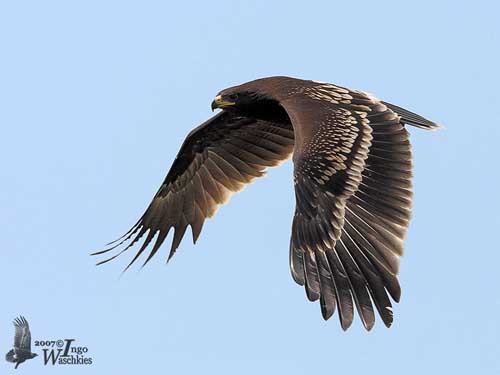
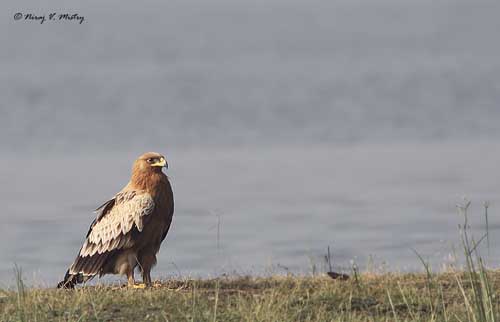
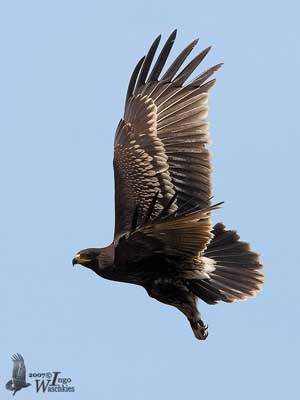
Greater Spotted Eagle
Clanga clanga
Accipitriformes Order – Accipitridae Family
INTRODUCTION:
The Greater Spotted Eagle was formerly included in the genus Aquila, with the scientific name Aquila clanga. It is closely related to the Little Spotted Eagle (Clanga pomarina).
The scientific name “clanga” is from Ancient Greek, meaning “scream” and giving this elegant raptor its French name “Aigle criard”.
The Greater Spotted Eagle is found in Europe, Asia, Indian Subcontinent, Africa, the Middle East and southern Asia.
During the breeding season, it usually frequents forest and woodland with adjacent wetlands used as foraging and feeding areas. But during winter, it can be found in wetlands and farmland, and also in forested habitats.
It feeds on various vertebrates, from small mammals, birds, amphibians and reptiles to small fish, and also carrion.
This species nests in a large structure made with sticks, placed below the canopy in deciduous tree. The male provides the food while the female incubates and rears the chick.
The Greater Spotted Eagle is threatened by habitat destruction, forestry operations, shooting in some parts of the range, and hybridization with C. pomarina. The species is suspected to be declining and is currently listed as Vulnerable.

DESCRIPTION OF THE BIRD:
Biometrics:
Length: 59-71 cm
Wingspan: 155-180 cm
Weight: M: 1500-1900 g – F: 1800-2500 g
The Greater Spotted Eagle adult of dark morph has uniform dark brown plumage overall. In fresh plumage, the upperparts show a strong purplish gloss. There is a whitish U-shaped area on the uppertail-coverts, mainly visible in flight.
The head is relatively small for an eagle.
The hooked bill is greyish-black with yellow cere and gape. The eyes are dark brown. The tarsi are feathered blackish-brown. The feet are yellow with black talons.
The Greater Spotted Eagle in pale morph “fulvescens” is very rare. This one has black tail, flight-feathers and greater wing-coverts. It is otherwise rufous to buff, with dark markings along breast and flanks, wing edges and around the eyes.
The juvenile “fulvescens” is very pale above but the flight-feathers and the tail are black.
Male and female have similar appearance but the female is slightly larger than the male.
The juvenile/immature shows white to yellowish spots on scapulars, back, rump and upperwing-coverts. These markings are larger and more numerous than in C. pomarina.
The tail is blackish with pale tips, whereas the underside of the flight-feathers is uniformly dark. The full adult plumage appears after 5-6 years.
RANGE:
The Greater Spotted Eagle is found in EC Europe, E through Russia to S Siberia and NE China. There are some isolated breeding populations in N Iran and NC India.
It winters from S Europe, S to NE and E Africa, and in the Middle East, Asia Minor and Transcaucasia to S and E China and Japan, S through Indochina to Malay Peninsula and Sumatra.
HABITAT:
The Greater Spotted Eagle usually frequents forested areas and wetlands, lowland forest and forest edges close to wet areas such as meadows, blogs and marshes, up to 1,000 metres of elevation. However, it has been recorded up to 4,000 metres in Iran.
During winter, it is found in wetter habitat than most eagles, and it frequents river delta, mangroves, marshes and lake margins. In Africa, it is mainly found in semi-arid acacia savanna.
Migrating and wintering individuals may sometimes frequent more open and drier habitats.
CALLS AND SONGS: SOUNDS BY XENO-CANTO
The Greater Spotted Eagle is usually silent, but during the breeding season, it produces a barking “kyak” often repeated, especially when several birds are present. The barking calls such as “kyak”, tyuck” and dyip” may be repeated 2-3 times.
The vocalizations are lower-pitched than those of C. pomarina.
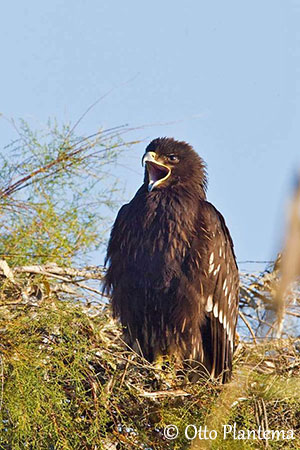
BEHAVIOUR IN THE WILD:
The Greater Spotted Eagle feeds mainly on small mammals, water birds, frogs, lizards, snakes, small fish, insects and carrion. Mammals include ground-squirrels, musk-rats and water voles, and some prey are as large as hares.
The Greater Spotted Eagle hunts in flight or from a perch in tree. In flight, it soars up to 100 metres high prior to dive down. It also waits for prey while perched in tree, and swoops down onto the prey when detected. The young eagles tend to forage and hunt by walking on the ground.
It also takes carrion with other raptors, and has been observed stealing food from other birds of prey, including of its own species, but also from Black Kite.

The Greater Spotted Eagle is territorial and monogamous. The male performs aerial displays including circling, high soaring and dives towards a soaring female. These displays are usually accompanied by loud calling.
This species builds a stick nest in tree, but also on rock or low bushes in treeless areas. The nest is often reused in several following years. Both adults take parts in nesting duties, but the male provides most of the food.
The Greater Spotted Eagle of the northern range is migratory and leaves the breeding grounds in winter, in October and November, to reach Central and Eastern Europe, N and E Africa, the Middle East, the Arabian Peninsula, India and E and SE Asia. It is a long-distance migrant. They return to the breeding areas in February and March.
The Greater Spotted Eagle soars with the wings at body level or with slightly downcurved hands pressed slightly forwards. While gliding, the wings are bowed with the hand clearly drooping.
During active flight, it performs rapid, shallow wingbeats, whereas while hunting slowly, it gives deeper, heavier and more laboured beats.
REPRODUCTION OF THIS SPECIES:
The breeding season varies depending on the range. But it takes place mainly between April and August, except for Indian Subcontinent where this species breeds in November/June and from May in Russia and N China.
The Greater Spotted Eagle is monogamous, territorial and solitary nester.
Both adults build the nest in tree, but depending on site availability, they also use rocks and low bushes when trees are absent. The large structure is made with sticks, and the central cup is lined with fresh green stems or grass. It is placed between 5 and 25 metres above the ground inside the forest, often in deciduous tree. The nest is usually reused year after year.
The female lays 1-3, usually 2 greyish eggs with brown and grey markings. She incubates alone during 41-44 days. At hatching, the chicks have white to greyish or grey-brown first down. The second down is pale grey but the head is darker.
The second chick rarely survives due to siblicide. The remaining chick fledges 60-67 days after hatching, but it still depends on adults for 3-4 weeks. During the breeding cycle, the male provides most of the food.
The Greater Spotted Eagle may interbreed with C. pomarina in a vast area of Eastern Europe. This behaviour is an additional threat for this vulnerable raptor, and contributes to the decline of this species.
PROTECTION / THREATS / STATUS:
The Greater Spotted Eagle is threatened by habitat destruction caused by deforestation and drainage of wetlands, but intensification of agriculture has reduced the quality of the foraging areas.
Shooting is another problem in several parts of the wide range. In addition, electrocution, collision with wind turbines and poisoning are major causes or mortality, with lead poisoning due to consumption of killed water birds.
Hybridization with C. pomarina appears to be spreading east, further into the range of the Greater Spotted Eagle. Hybridization between these two raptors has been reported in all countries where they exist together.
A very preliminary estimate of the global population size is 3,900/10,000 mature individuals. But more information is needed.
The Greater Spotted Eagle is suspected to be declining and the species is currently listed as Vulnerable.